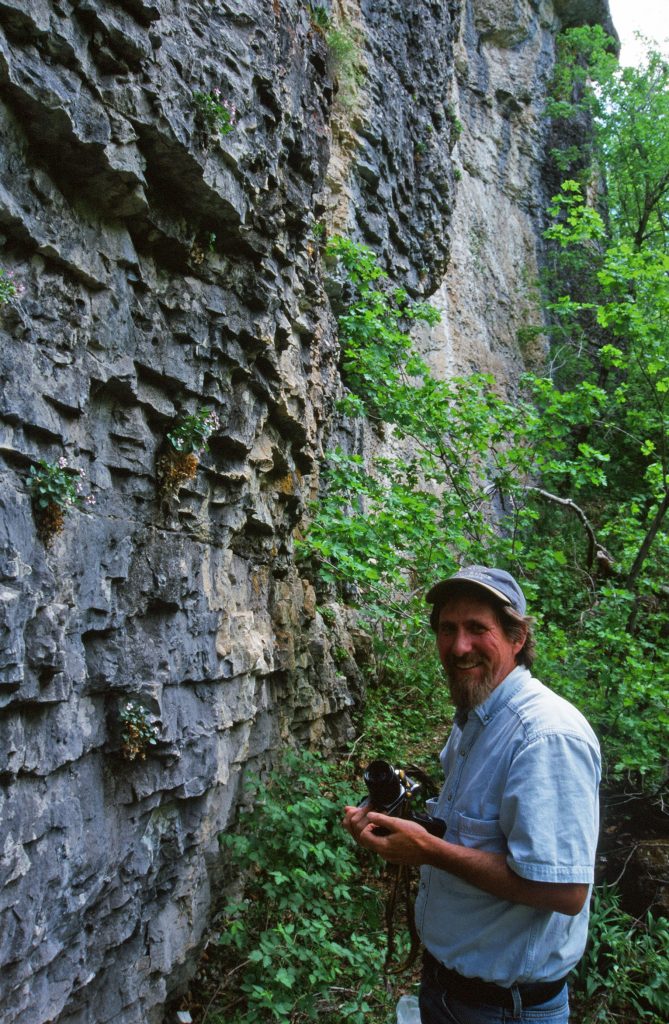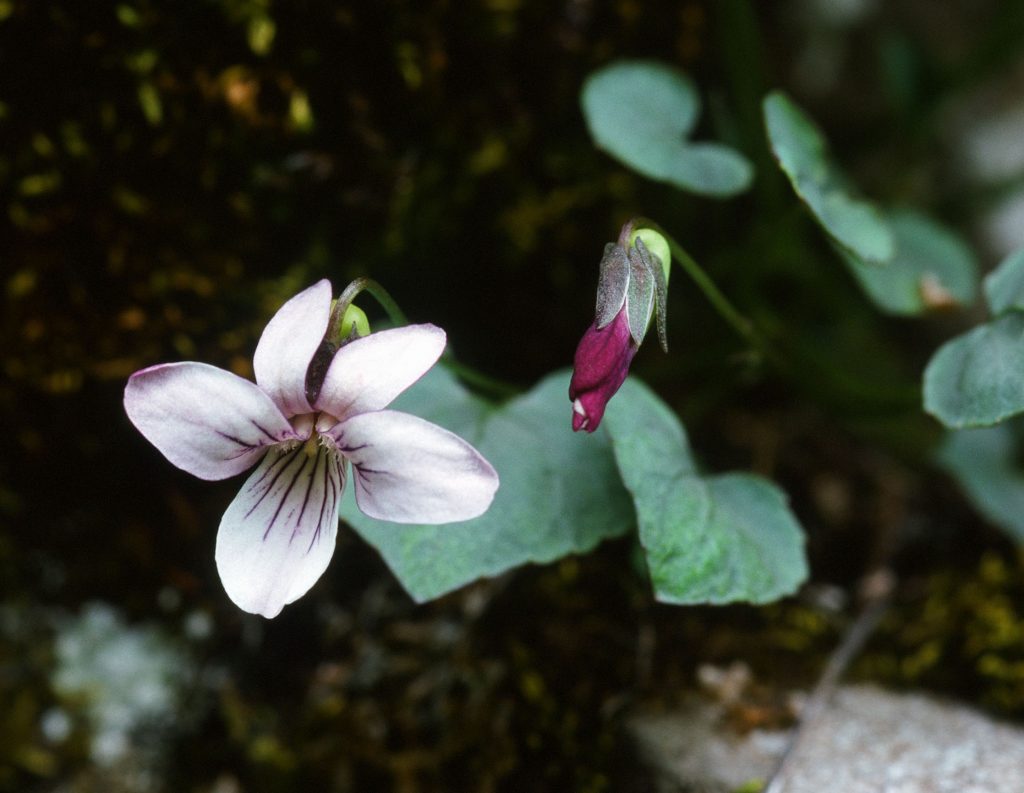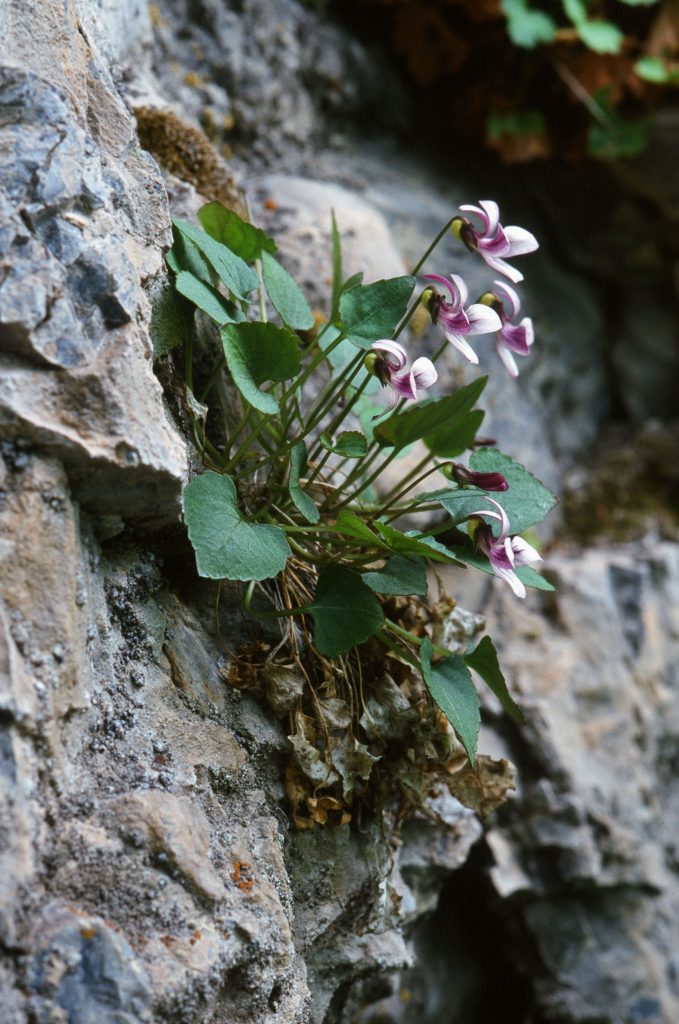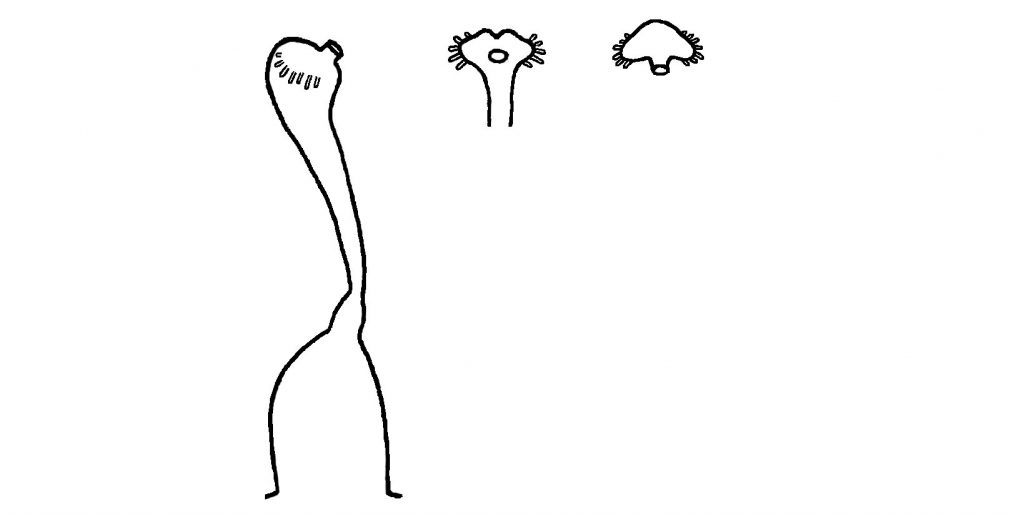Viola frank-smithii N. H. Holmgren
Description. Illustrations: 4 photographs of Viola frank-smithii (1 with Frank Smith) and 2 drawings.

One of three new violet species discovered in North America between 1980 and 1990, all of which grow in limestone or dolomite in the presence of conifers, either Douglas Firs or Bristlecone pines. Although this species is not quite as rare as the two other newly discovered violets V. guadalupensis and V. lithion, V. frank-smithii is an endangered species occurring only in a very limited habitat.
Frank Smith’s violet occurs as perennial, clustered plants growing in the crevices of vertical rock walls, the older plants having a persistent mass of dead leaves hanging beneath from the growth of previous years. Glabrous plants arise from a short rhizome, the stems, petioles and peduncles spreading or declining from the vertical rock face; older plants growing to 10 cm, their stems 1.5-6.5 cm long at flowering. Its leaves are heart-shaped and turn golden-yellow in autumn. The flowers are pale violet in color but red-purple on the back of the petals and the rounded petal spur is lime-green.

Both basal and cauline leaves are present; basal leaves broadely ovate-cordate usually cordate at their base; cauline leaves narrower, deltate-cordate with truncate bases; margins crenate and often purple towards the tip, decurrent on petiole for half of its length, leaves pointed at the tip. Leaves are glaucous, sometimes with purple veins and purple on the underside of the leaves. Basal leaf stipules are adnate to the petiole, lanceolate, with glandular-tipped fimbriae, 1.2 cm long. The ovary is green; style head bilobed with short projections around the sides of the lobes. Bracteoles in the lower half of the peduncle have a few short fimbriae, 0.2 cm long.

The flowers, produced from mid-May to August, are 2.0 cm long x 1.8 cm wide. Petals are dark red-purple on their outer surface and pale lilac on the inner surface with red-purple guidelines on the three lowest petals, those on the lateral petals heavily smudged. Hairs on the inside of the lateral petals are tapered to a point; the spurred petal end notched. The lime green spur is rounded, 2.0 mm long, 3.0 mm wide x 2.5 mm thick, with a red-purple line on the lower side extended from the central guideline of the lowest petal. Seed pod and seed details are not yet recorded, however the seed will most likely be attractive to ants as this species is reliant for survival on dispersal of its seeds in rock crevices. Calyx purple, 0.5 cm long; sepals with obvious hyaline margins, appendages acute apically.

A few populations of V. frank-smithii are on limestone but the majority of occurrences are on dolomite, between 1525 and 2075 m (5,000 and 6,800 ft) elevation. Most locations are cool, northerly exposures that remain shaded for at least part of the day. Dense stands of Douglas Fir (Pseudotsuga menziesii) also shade the plants, similar to the habitat of V. guadalupensis, with Acer grandidentatum and A. glabrum as understory on surrounding Canyon slopes. V. frank-smithii occupies the barest of crevices without any noticeable soil accumulations, but plants do not grow in the soil at the base of the rock-face.
This violet is endemic to the Wasatch-Cache National Forest, Logan Canyon and its tributaries, in Cache County of northeastern Utah. There are about a dozen known locations with an estimated total population size of approximately ten thousand plants.

Nomenclature and Taxonomy
Viola frank-smithii N.H.Holmgren — Brittonia 44: 303, figs. 1E-H. 1992.
First collected 1990.
Section Chamaemelanium Becker, subsection Canadenses (Marcussen, 2011).
When Holmgren first described V. frank-smithii in 1992, he placed it in Section Rostellatae Boiss., subsection Rosulantes Borbas. This group has a base chromosome number, n = 10. More recently, Dr. Harvey Ballard of Ohio University, obtained a tentative unconfirmed count of n = 12. He concluded from this information that V. frank-smithii cannot be included in the rostrate violets and surmised that it could belong with the Bilobatae (n=12), from eastern Asia. However, although the stigmatic head of V. frank-smithii is bilobed, it also has hairs around the sides of the lobes while the Bilobate have no hairs or projections. The style head is typical of Section Chamaemelanium, subsection Canadenses (n=12). One complication to this new proposal is that the flowers of all other species of subsection Canadenses are characterised by a central yellow throat and clavate hairs on the lateral petals. V. frank-smithii does not have a yellow throat, but does have a yellow to lime-green spur, similar to V. flettii and V. lithion. The hairs on the inside of its lateral petals are straight. Harvey Ballard’s tentative chromosome count needs to be confirmed, and its relationship to the subsection Canadenses elucidated by detailed chromosome analysis. In the meantime, it seems reasonable to conclude, based on the diploid chromosome number, that Frank Smith’s violet is a relict species, as is V. flettii, probably from a time when the climate in western North America was much colder and wetter than it is now, i.e. during the pluvial period of the last glaciation.
V. frank-smithii displays many similarities with V. flettii: smudged purple on lateral petals, same dark red-purple colour on outside of petals, purple sepals, short thick spur of green-yellow colour, cordate leaf shape, glaucous glabrous leaves with purple on underside in some populations, purple leaf venation, bilobed style head with short projections on sides of lobes, similar style head similar and that no plants grow in soil at the base of the rock-face.
However, it differs from V. flettii by: more pointed leaves, the presence of persistent dead leaves, pale flowers, end of lowest petal notched (V. flettii pointed), longer spur, lower bracteole position, tapered straight hairs on lateral petals (V. flettii clavate, also all other members of subsection Canadenses) and no yellow in its throat.
